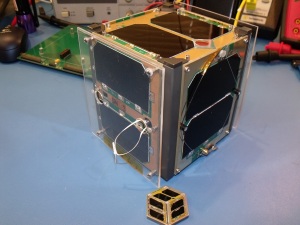The amateur radio FM transponder CubeSat, AO-85 (Fox-1A), was among 13 CubeSats flying as secondary payloads on the NROL-55 mission.
The launch took place at 12:49:30 UT on Thursday, October 8, 2015 on a United Launch Alliance Atlas V rocket from Vandenberg Air Force Base in California.
Jan van Gills PE0SAT in the Netherlands reported receiving Fox-1A at 1724 UT and Masahiro Arai JN1GKZ received it at 1746 UT in Japan. Ken Eaton GW1FKY said “I am hearing Fox-1A here in Wales – UK on the pass 2029 hrs Zulu. The announcement – Fox One Speech Mode – is very loud and clear. Congratulations to all involved in the success of the launch activation and support for the project.”
The FM voice transponder on AO-85 was activated during Friday, October 9 allowing many contacts to be made. Among those active on the satellite was 9-year-old Hope KM4IPF.
Hope is the daughter of Michelle N8ZQZ and James WX4TV, other radio amateurs in the family are Hope’s elder sister Faith WA4BBC and brother Zechariah WX4TVJ, her younger sister is studying for her licence.
In this video Hope KM4IPF describes her first AO-85 (Fox-1A) contact
AO-85 is a 1-Unit CubeSat carrying an FM repeater that will allow simple ground stations using an HT and an “Arrow” or “Elk” type antenna to make contacts using the satellite. Data Under Voice (DUV) is used to send 200 bps FSK telemetry data at the same time as FM audio. This is achieved by making use of sub-audible frequencies below 200 Hz.
AO-85 frequencies, see Operating Guide to set up your radio’s memory channels based on the nominal frequencies of 435.180 and 145.980 MHz. Measurements after launch indicate these center frequencies may be a better choice:
435.170 MHz (+/- 10 kHz Doppler shift) FM Uplink 67 Hz CTCSS PL tone required
145.978 MHz (+/- 3 kHz Doppler shift) FM Downlink
Note: If your rig has selectable FM filters use the wider filter for 5 kHz deviation 25 kHz channel spacing.
David Bowman G0MRF reports that the AO-85 downlink appears to be 2 kHz low of the nominal frequency on about 145.978 MHz. This suggest that for those with radios which have 5 kHz tuning steps best results might be obtained by tuning to 145.980 MHz at the start of the pass and then tuning to 145.795 MHz mid-way through the pass.
Measurements made by Alan Biddle WA4SCA indicate the downlink is consistently 1.400 kHz low at 145.9786 MHz. Reports indicate the uplink may be 10 kHz low of nominal frequency – 435.170 MHz.
Listen online to the signal from AO-85 when it’s in range of London from anywhere in the world by using the SUWS WebSDR remote receiver. Select Frequency: 145980 kHz and Mode: FM – http://websdr.suws.org.uk/
AO-85 Real-time track and Orbital Predictions (click on Draw Footprint to show coverage area)
http://www.n2yo.com/?s=40967
Read the Fox Operating Guide to find out how to set up your handheld radio to work the satellite
http://www.amsat.org/wordpress/wp-content/uploads/2015/05/FoxOperatingGuide_May2015_Hi.pdf
Download your free copy of the AMSAT Journal Fox-1A Launch special issue
You can also report hearing or not hearing it on http://www.amsat.org/status/
You can upload data using the FoxTelem telemetry program that was released by Chris Thompson, G0KLA. (Check the “upload to server” box in the properties/preference page). More data will help us do the checkout faster! Remember if you hear the “telephone modem” sound, you must switch FoxTelem to high-speed mode manually. Similarly FoxTelem must be in low-speed mode at other times.
Information on the free Fox telemetry decoder software is at
https://amsat-uk.org/2015/09/23/fox-telemetry-decoder-software/
Note: Please make sure “upload to server” is enabled in decoder settings
Fox-1A Telemetry Leaderboard Statistics http://www.amsat.org/tlm/
Fox-1A (AO-85) Launched https://amsat-uk.org/2015/10/07/fox-1a-launch/
Jerry Buxton, N0JY talking about Fox-1A on NASA TV
https://amsat-uk.org/2015/10/07/radio-amateurs-on-nasa-tv/


You must be logged in to post a comment.